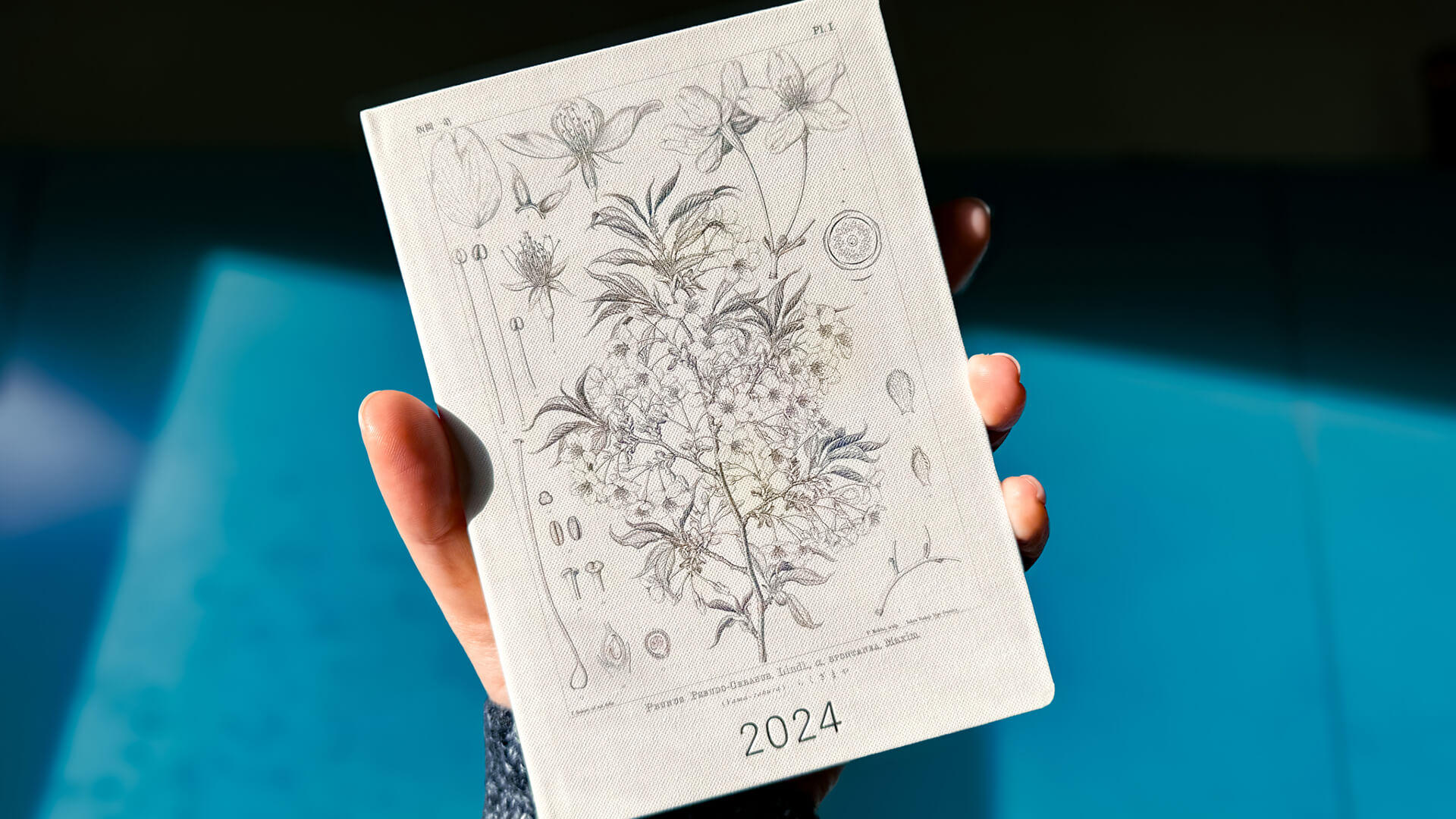January always brings the excitement of starting fresh with a blank planner. This year, I’ve decided to go for the Hobonichi 2024 Hon. Unlike many of Hobonichi’s traditional Techo planners, the Techo Hon stands out with its unique hardcover book-like style. It’s a more simplified approach without the need for a bulkier cover to slip the planner into, and I really like its aesthetic for use in both personal and professional settings.
This is especially important as I have decided to merge my work and personal tasks into this single, streamlined planner this year. Normally, I keep work and life tasks completely separate, but I thought I would try combining them for a more minimalist set-up this year.
Now, after two weeks of use, I’m finding this new approach to be surprisingly effective. The Hobonichi Techo’s layout and functionality is great for combining my day-to-day work and personal to-dos. It’s also useful to have my daily schedules recorded here for quick reference. In this article, I’ll share my review of the 2024 Hobonichi Hon and some thoughts on how it has improved my everyday planning for work and personal goals.
Contents 1. Design of the Hobonichi 2024 Hon Techo 2. My daily task management system 3. Using the Hobonichi Techo to track monthly and yearly goals Final Thoughts
1. Design of the Hobonichi 2024 Hon Techo
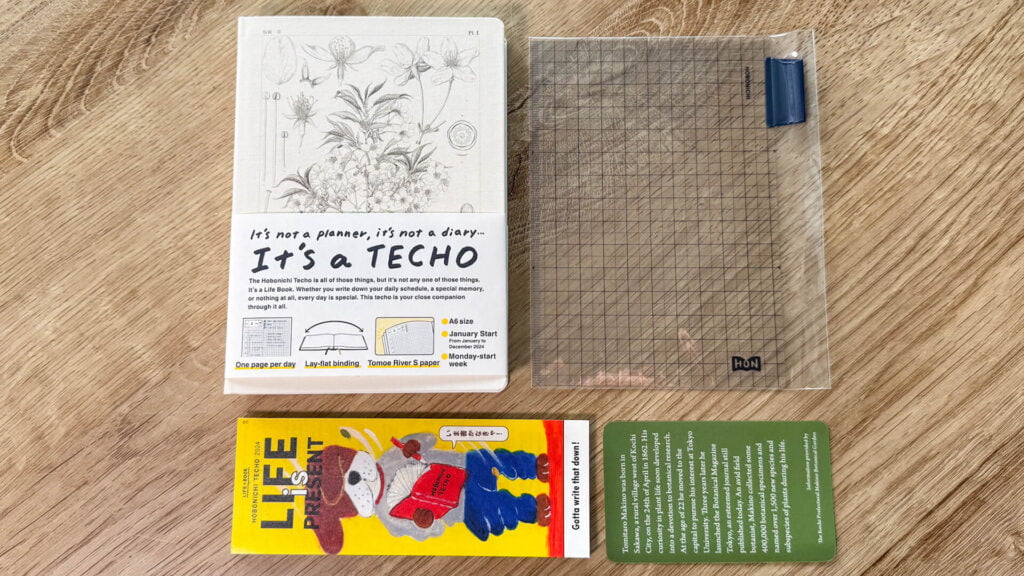
I decided to go for the smaller A6 Hobonichi Hon as I wanted something compact that I could throw into my bag for work or have open beside my laptop. I’m not using the planner as a daily diary where I need a lot of space for writing, but using it to set out daily tasks, my schedule for the day, events, goals and daily gratitude. The A6 provides more than enough space for all of this.
There are a few different designs for the Hobonichi Hon this year and I was really torn on which one to go for. In the end, I went for the Tomitaro Makino: Yamazakura cover as the illustration is so unique and it looks elegant but still professional. The cover has a fabric texture and feels lovely.
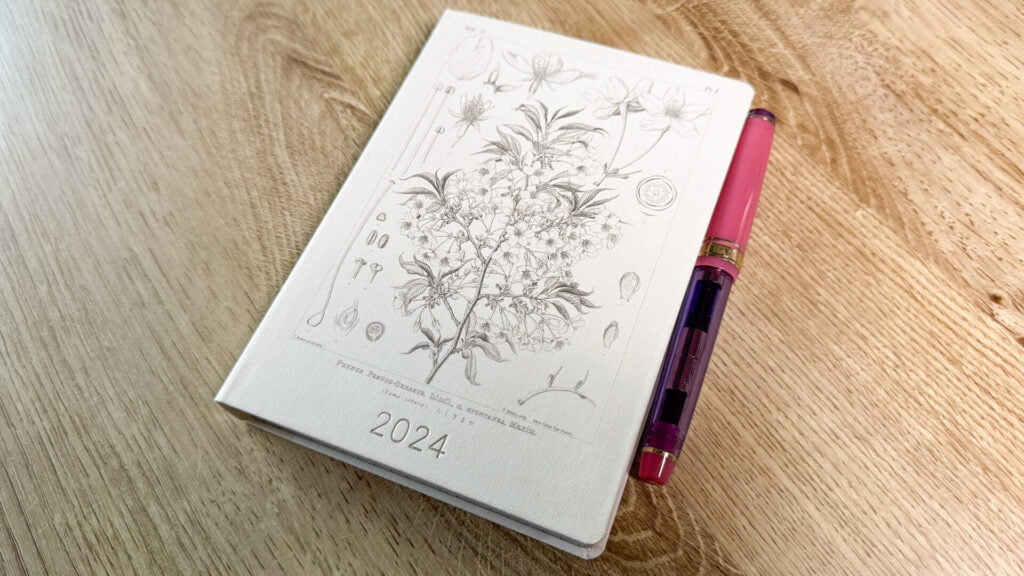
The Hobonichi Hon also comes with a pencil board that has a loop that you can latch your pen onto. It’s a perfect fit for my Sailor Pro Gear Slim Manyo fountain pen to clip on to.
Sanzen Tomoe River Paper
The 2024 Hobonichi Hon pages are made from the new Sanzen Tomoe River paper. This is to replace the former Tomoegawa Tomoe River Paper that Hobonichi discontinued last year.
The Sanzen paper is crisp, very clean and doesn’t bleed at all when used with fountain pen ink. I also noticed that the ink doesn’t show through on the other side of the page as much as it did with previous Hobonichi planners using the old Tomoe River paper. There is still a bit of ghosting (see the picture in the following section) from the Sailor Manyo Ink that I am using, but it is very subtle.
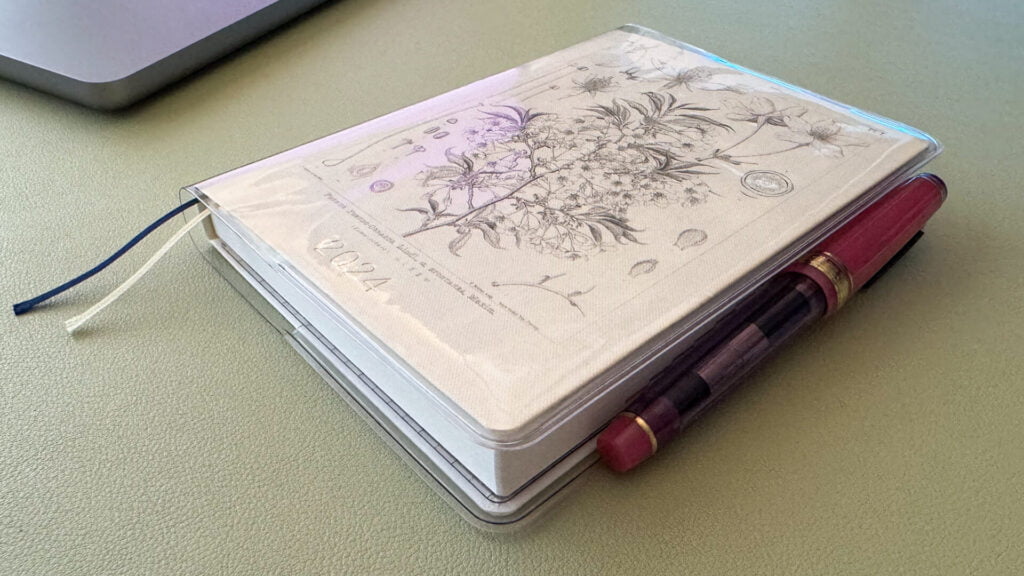
Does the Hobonichi Hon fit into a cover?
Yes! This was a relief to discover as I was worried that the cream fabric cover might get marked in my bag or when out and about. The clear plastic A6 Hobonichi Hon cover means that I can wipe down and clean the exterior if I get anything on it.
It was a little tricky to find the A6 Hon clear cover in the UK, but I was able to get the official Hobonichi Hon transparent cover from Art from the Heart for £7.50. The Hon fits in the cover perfectly, although it does extend by around 5 mm around the edges.
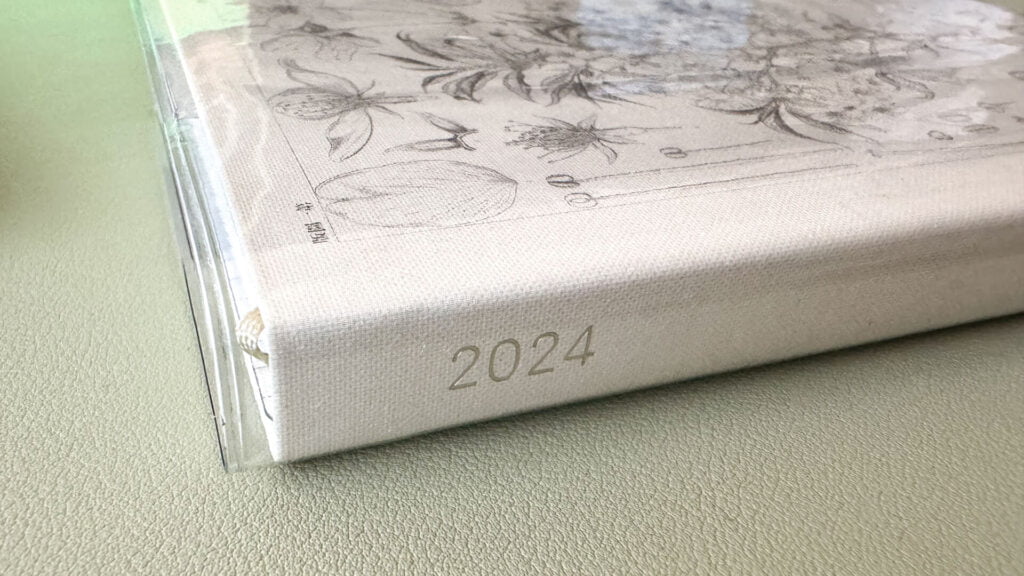
2. My daily task management system with the Hobonichi Hon
I am keeping my Hobonichi Hon purely functional and have found that the layout of the daily pages is perfect for combining my work and personal tasks.
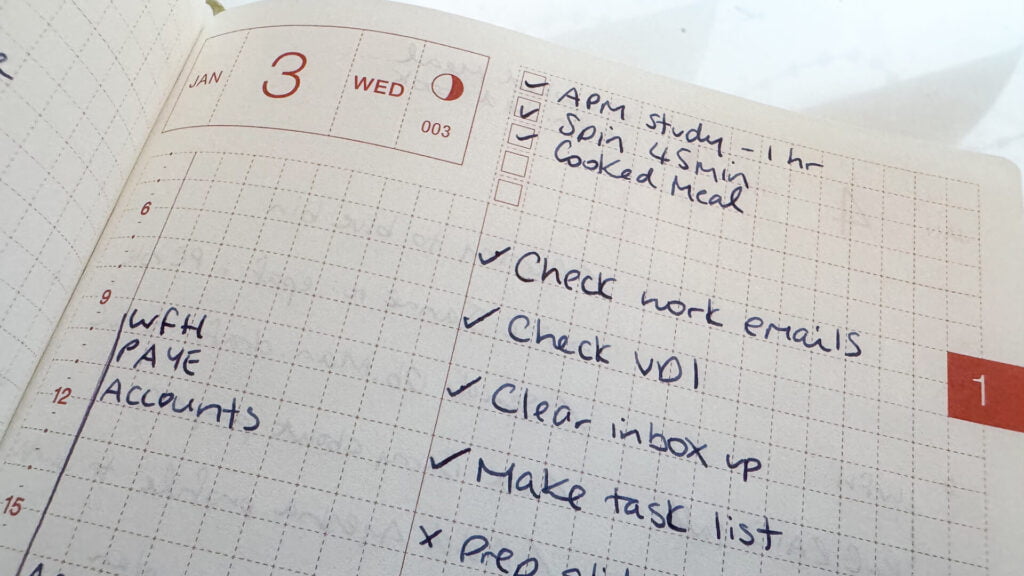
Timeline Column for Daily Schedule
Here I will keep track of my schedule for the day. On weekdays, I record the time I start and end work (if I’m working from home, I label this as WFH) and draw a vertical line on the left to show the length of my work day. This line also helps me see quickly if events listed next to it are work meetings.
I’ll also put in any time I want to set aside for goal-related tasks like workouts or studying, so I can look back to see how many hours I’ve spent each week working towards fitness or professional development goals.
Main Section for Daily To-dos
The main section to the right of the timeline column is where I list out all of my to-dos for the day. Sometimes I’ll know well in advance that something needs to be done on a certain date, so I have to-dos listed in future daily pages in my planner. Each morning, I’ll spend a few minutes fleshing out the full to-do list. A few more tasks usually get added in as I go through the day.
I used to keep a bullet journal and still use elements of this system to structure the task list:
[•] Normal bullet point: A task that needs to be completed [✔] Tick: To mark off that a task is done [→] Arrow: The task has been moved to a later date [✘] Cross: The task is no longer required [-] Line: The task has been started but not completed
As I mentioned earlier, this year I’m using the Hobonichi Hon for work and personal tasks, so my to-do list will be a mixture of everything I need to do during the work day as well as in my own time. I like that this makes me aware of what needs to be done so that I’m strict with my schedule. I’m less likely to be tempted to work late when I can see that there are quite a few things to get done at home in the evening.
The Tick-box List at the Top
This is where I’ll keep track of the tasks I’d ideally like to do every day, but don’t always do. These are things like workouts, meditation, studying and deep cleaning.
I only write them down if I do them, so that makes it easy to glance back through previous days to see how often I neglect these areas! I also know that I’m never going to do all of these ‘ideal’ daily tasks every day, so it would be unproductive for me to write them all in each day when I know that they aren’t all going to get ticked off. Having this section remain blank is also good for putting some pressure on to do at least one of these things each day so I have something to list here.
3. Using the Hobonichi Techo to track monthly and yearly goals
I have a few monthly and annual goals that I like to keep track of in the Hobonichi Hon so that they’re always there as a reminder.
Monthly Goals
I list my monthly goals on the blank page that the Hobonichi Hon has at the start of each month. Thankfully, the Sanzen Tomoe River paper still lets you see the gridlines on the opposite side of the page well enough that it’s easy to write in straight lines on these blank pages.
My monthly goals include things like ‘complete 10 spin classes’ or ‘study for 15 hours’. I prefer to put a fixed number on these goals, rather than keeping them vague (like ‘exercise regularly’). A tangible number means you can see exactly where you are in terms of reaching the goal and lets you measure your progress clearly.
In the monthly spread at the start of the Hobonichi Hon, I’ll record my progress towards these monthly goals. These are listed on the days that I do them as ‘1hr spin’ or ‘0.5hrs study’ so I can quickly count up and see how close I am to ticking off the monthly goal.
Yearly Goals
Before the January daily pages, there is a double-page grid that is titled ‘turning the page to a new year’. This is where I list out all of the things that I want to achieve in 2024.
I don’t need to consult this page just as regularly as I will use my monthly goals to achieve my annual goals. At the start of each month, when I’m planning out my monthly goals, I’ll check my annual goals page to see what I could try to achieve that month to tick things off.
This makes my goal-setting like a funnel process, where the annual goals dictate how I shape my monthly goals, which then feed down into how I structure my weekly and daily tasks.
I also use the ‘My 100’ list at the back of the Hobonichi Hon to record some of the tangible goals that I have set for the year. I’ve split this into four lists of 25 rather than a single list of 100, so I can track progress across four areas.
One of these is to record book titles as I’m aiming to read at least two fictional books each month. I’ve been using the first column in the My 100 list to note down the titles of the books as I go along.
Final Thoughts
There are a lot more sections to the Hobonichi Hon that I haven’t covered here, and that’s because I haven’t been using them. I’m trying to keep my daily use of the planner as streamlined and functional as possible. I know that if I start trying to track a lot more areas then it will become a bit of a chore, so I’m using this in the most minimalist way that I can with productivity, accountability and efficiency as my main objectives.
So far, I’ve been really enjoying using the Techo Hon to combine my work and personal tasks – it will be interesting to see how my thoughts on this are after a few months. Maybe I won’t want to be reminded about the existence of work when I’m on vacation, and seeing those work tasks in the planner when I’m using it purely for personal to-dos will annoy me. I’ll update at the end of the year to see if it did work out or if I’ll go back to keeping separate systems next year.
What I can say is that the Hobonichi Hon is definitely my preferred option over the Hobochini Cousin that I used previously. I really love the hard-back cover of the Hon and how I don’t need to use a bulkier planner cover to store it inside. Even with the clear plastic cover on, it looks professional and discreet – I can carry this with my laptop and notebook for meetings easily when I’m in the office.
One thing that I know for certain is that I will definitely be getting another Hobonichi Hon for 2025. I’m already so excited to see what the designs for next year will be like!

